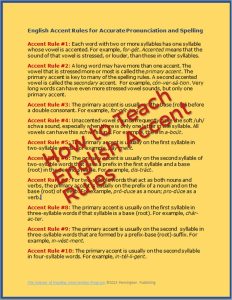How to Teach English Accent Rules
Teachers often struggle with how to teach English accent rules for multi-syllabic words. Teaching students the syllable and accent rules

How to Teach English Accent Rules
through effective practice will noticeably improve their word attack and spelling skills. The accent rules and teaching procedure work well for both primary English speakers and English language-learners at all grade levels.
How to Teach English Accent Rules
- Teach students that every syllable has one vowel sound.
- Teach students the syllable patterns. Teaching inductively from examples to rules works much better than the converse strategy. Here’s How to Teach Syllables (includes a great free resource) without all the CVC, CVVC, etc. jargon.
- Show students how accented syllables are louder than others in the same word. Stand in front of students with one hand at your side. State your preferred title e.g. Mr., Ms., or your first name as a verbal cue and then snap and clap the syllables of your last name slowly. A snap indicates the unaccented syllable and a clap indicates the accented syllable. Don’t clap more than once in your last name even if there is a secondary accent. Save this instruction for high school. Note: For primary students, you may wish to substitute a thigh tap for the snap. Tell older students to fake the snap if they can’t do it. If your last name is only one syllable, e.g. Smith, adopt a pseudonym.
Ask students do the same, cueing them with your title. Repeat a bit faster and then once more quite quickly so that students are blending your last name. Ask for a few student volunteers to demonstrate with their last names. The teacher should cue with their first names.
-
- Show students how accented syllables are higher than others in the same word. Stand in front of students with one hand at your side. State your title (Mr. Miss, Ms. or Mrs.) or your first name as a verbal cue and then swipe and hold your hand away from your body to indicate the pitch of each syllable as you pronounce your last name. For example, Say, “Mister…” (hand at side) “Pen” (high pitch; hand swiping to and held at a ninety degree angle) “ning” (low pitch; hand swiping lower and held at forty-five degree angle) “ton” (low pitch; hand swiping again and held at same forty-five degree angle). “Pen-ning-ton. Pennington.” Ask students to stand and do the same, cueing them with your title. Repeat a bit faster and then once more quite quickly so that students are blending your last name. Ask for a few student volunteers to demonstrate with their last names. The teacher should cue with their first names.
- Practice the louder and higher syllable accenting with the 10 Accent Rules. Download this great resource.
Get the English Accent Rules FREE Resource:
![]()

The Science of Reading Intervention Program
The Science of Reading Intervention Program: Word Recognition includes explicit, scripted, sounds to print instruction and practice with the 5 Daily Google Slide Activities every grades 4-adult reading intervention student needs: 1. Phonemic Awareness and Morphology 2. Blending, Segmenting, and Spelling 3. Sounds and Spellings (including handwriting) 4. Heart Words Practice 5. Sam and Friends Phonics Books (decodables). Plus, digital and printable sound wall cards, speech articulation songs, sounds to print games, and morphology walls. Print versions are available for all activities. First Half of the Year Program (55 minutes-per-day, 18 weeks)
The Science of Reading Intervention Program: Word Recognition includes explicit, scripted, sounds to print instruction and practice with the 6 Daily Google Slide Activities every grades 4-adult reading intervention student needs: 1. Phonemic Awareness 2. Blending, Segmenting, and Spelling 3. Sounds and Spellings (including handwriting) 4. Heart Words Practice 5. Sam and Friends Phonics Books (decodables). Plus, 6. Digital and printable sound wall cards, Elkonin sound box dictations, speech articulation songs, sounds to print games, and multi-syllabic decoding. Print versions are available for all activities. First Half of the Year Program (55 minutes-per-day, 18 weeks)
The Science of Reading Intervention Program: Assessment-based Instruction provides diagnostically-based “second chance” instructional resources. The program includes 13 comprehensive assessments and matching instructional resources to fill in the yet-to-be-mastered gaps in phonemic awareness, alphabetic awareness, phonics, fluency (with YouTube modeled readings), Heart Words and Phonics Games, spelling patterns, grammar, usage, and mechanics, syllabication and morphology, executive function shills. Second Half of the Year Program (25 minutes-per-day, 18 weeks)
The Science of Reading Intervention Program BUNDLE includes all 3 program components for the comprehensive, state-of-the-art (and science) grades 4-adult full-year program. Scripted, easy-to-teach, no prep, no need for time-consuming (albeit valuable) LETRS training or O-G certification… Learn as you teach and get results NOW for your students. Print to speech with plenty of speech to print instructional components.
Click the SCIENCE OF READING INTERVENTION PROGRAM RESOURCES for detailed program description, sample lessons, and video overviews. Click the links to get these ready-to-use resources, developed by a teacher (Mark Pennington, MA reading specialist) for teachers and their students.
Get the SCRIP Comprehension Cues FREE Resource:
![]()
Get the Diagnostic ELA and Reading Assessments FREE Resource:![]()
*****


